Transmissive Mode Laser Micro-Ablation Performance of Ammonium Dinitramide-Based Liquid Propellant for Laser Micro-Thruster
Abstract
1. Introduction
2. Materials and Methods
2.1. Experimental Items and Devices
2.2. Liquid Propellant Formulation
2.3. Absorption Depth Measurement of Liquid Propellants
2.4. Thermal Analysis Measurement of Liquid Propellants
2.5. Ablation Characteristics Measurement with Torsion Pendulum
3. Results and Discussions
3.1. Laser Energy Deposition Characteristics of ADN-Based Liquid Propellants
3.2. Energetic and Thermal Release Properties of ADN-Based Liquid Propellants
3.3. Laser Micro-Ablation Performance of ADN-Based Liquid Propellants
3.4. Mechanism Analysis of Laser Micro-Ablation of ADN-Based Liquid Propellants
4. Conclusions and Future Work
Supplementary Materials
Author Contributions
Funding
Data Availability Statement
Conflicts of Interest
References
- Wilhelm, M.; Negri, M.; Ciezki, H.; Schlechtriem, S. Preliminary tests on thermal ignition of ADN-based liquid monopropellants. Acta Astronaut. 2019, 158, 388–396. [Google Scholar] [CrossRef]
- Li, L.; Li, G.X.; Li, H.M.; Yao, Z.P. Effect of voltage and droplet size on electrical ignition characteristics of ADN-based liquid propellant droplet. Aerosp. Sci. Technol. 2019, 93, 105314. [Google Scholar] [CrossRef]
- Kumar, P. Advances in phase stabilization techniques of AN using KDN and other chemical compounds for preparing green oxidizers. Defence Technol. 2019, 15, 949–957. [Google Scholar] [CrossRef]
- Kim, J.W.; Baek, S.; Jung, Y.S.; Yoon, W.; Ban, H.S.; Kwon, S. An alternative ADN based monopropellant mixed with tetraglyme. Acta Astronaut. 2021, 178, 241–249. [Google Scholar] [CrossRef]
- Maleix, C.; Chabernaud, P.; Brahmi, R.; Beauchet, R.; Batonneau, Y.; Kappenstein, C.; Schwentenwein, M.; Koopmans, R.J.; Schuh, S.; Scharlemann, C. Development of catalytic materials for decomposition of ADN-based Monopropellants. Acta Astronaut. 2019, 158, 407–415. [Google Scholar] [CrossRef]
- Hou, Y.Y.; Yu, Y.S.; Liu, X.H.; Chen, J.; Zhang, T. Experimental study on microwave-assisted ignition and combustion characteristics of ADN-based liquid propellant. ACS Omega 2021, 6, 22937–22944. [Google Scholar] [CrossRef] [PubMed]
- Negri, M.; Wilhelm, M.; Ciezki, H.K. Thermal ignition of ADN-based propellants. Propellants Explos. Pyrotech. 2019, 44, 1096–1106. [Google Scholar] [CrossRef]
- Freudenmann, D.; Ciezki, H.K. ADN and HAN-Based monopropellants–A minireview on compatibility and chemical stability in aqueous media. Propellants Explos. Pyrotech. 2019, 44, 1084–1089. [Google Scholar] [CrossRef]
- Chen, X.J.; He, L.C.; Li, X.R.; Zhou, Z.Y.; Ren, Z.Q. Molecular simulation studies on the growth process and properties of ammonium dinitramide crystal. J. Phys. Chem. C 2019, 123, 10940–10948. [Google Scholar] [CrossRef]
- Elishav, O.; Lis, B.M.; Miller, E.M.; Arent, D.J.; Medina, A.V.; Dana, A.G.; Shter, G.E.; Grader, G.S. Progress and prospective of nitrogen-based alternative fuels. Chem. Rev. 2020, 120, 5352–5436. [Google Scholar] [CrossRef]
- Itouyama, N.; Matsunaga, H.; Habu, H. Characterization of continuous-wave laser heating ignition of ammonium dinitramide-based ionic liquids with carbon fibers. Propellants Explos. Pyrotech. 2020, 45, 988–996. [Google Scholar] [CrossRef]
- Persson, M.; Anflo, K.; Friedhoff, P. Flight heritage of ammonium dinitramide (ADN) based high performance green propulsion (HPGP) systems. Propellants Explos. Pyrotech. 2019, 44, 1073–1079. [Google Scholar] [CrossRef]
- Hou, Y.Y.; Yu, Y.S.; Liu, X.H.; Cao, J. Effect of combustion chamber geometrical parameters on the decomposition and Combustion characteristics of an ADN-based thruster. Micromachines 2022, 13, 605. [Google Scholar] [CrossRef] [PubMed]
- Zhang, T.; Wang, F.S.; Chen, J. Analysis of porosity and preheating temperature on the decomposition and combustion characteristics within 5 N ammonium dinitramide (ADN)-based monopropellant thruster. J. Therm. Sci. 2020, 29, 81–89. [Google Scholar] [CrossRef]
- Li, Y.J.; Xie, W.X.; Wang, H.Y.; Yang, H.T.; Huang, H.T.; Liu, Y.F.; Fan, X.Z. Investigation on the thermal behavior of ammonium dinitramide with different copper-based catalysts. Propellants Explos. Pyrotech. 2020, 45, 1607–1613. [Google Scholar] [CrossRef]
- Li, H.M.; Li, G.X.; Li, L.; Yao, Z.P. Experimental study on thermal ignition and combustion of droplet of ammonium dinitramide based liquid propellant in different oxidizing gas atmospheres. Acta Astronaut. 2020, 169, 40–49. [Google Scholar] [CrossRef]
- Liu, B.d.; Li, X.R.; Yang, J.H.; Gao, G.H. Recent advances in MEMS-based microthrusters. Micromachines 2019, 10, 818. [Google Scholar] [CrossRef]
- Tummala, A.R.; Dutta, A. An overview of cube-satellite propulsion technologies and trends. Aerospace 2017, 4, 58. [Google Scholar] [CrossRef]
- Gohardani, A.S.; Stanojev, J.; Demairé, A.; Anflo, K.; Persson, M.; Wingborg, N.; Nilsson, C. Green space propulsion: Opportunities and prospects. Prog. Aerosp. Sci. 2014, 71, 128–149. [Google Scholar] [CrossRef]
- Rovey, J.L.; Lyne, C.T.; Mundahl, A.J.; Rasmont, N.; Glascock, M.S.; Wainwright, M.J.; Berg, S.P. Review of multimode space propulsion. Prog. Aerosp. Sci. 2020, 118, 100627. [Google Scholar] [CrossRef]
- Yu, H.C.; Li, H.Y.; Wang, Y.; Cui, L.G.; Liu, S.Q.; Yang, J. Brief review on pulse laser propulsion. Opt. Laser Technol. 2018, 100, 57–74. [Google Scholar] [CrossRef]
- Yu, H.C.; Li, H.Y.; Wu, X.; Yang, J. Dynamic testing of nanosecond laser pulse induced plasma shock wave propulsion for microsphere. Appl. Phys. A 2020, 126, 63. [Google Scholar] [CrossRef]
- Felicetti, L.; Santoni, F. Nanosatellite swarm missions in low Earth orbit using laser propulsion. Aerosp. Sci. Technol. 2013, 27, 179–187. [Google Scholar] [CrossRef]
- Yu, H.C.; Cui, L.G.; Zhang, K.; Yang, J.; Li, H. Effect of a fiber-capillary structure on nanosecond laser pulse propulsion. Appl. Phys. A 2018, 124, 37–42. [Google Scholar] [CrossRef]
- Myrabo, L.N.; Libeau, M.A.; Meloney, E.D.; Bracken, R.L.; Knowles, T.B. Pulsed laser propulsion performance of 11-cm parabolic bell engines within the atmosphere. In Proceedings of the SPIE High-Power Laser Ablation V, Taos, NW, USA, 25–30 April 2004; Volume 5448, pp. 450–464. [Google Scholar]
- Lemmer, K. Propulsion for CubeSats. Acta Astronaut. 2017, 134, 231–243. [Google Scholar] [CrossRef]
- Lee, D.; Kim, J.; Kwon, S. High performance microthruster with ammonium-dinitramide-based monopropellant. Sens. Actuator A Phys. 2018, 283, 211–219. [Google Scholar] [CrossRef]
- Markandan, K.; Chin, J.K.; Cheah, K.H.; Tan, M. Recent developments in ceramic microthrusters and the potential applications with green propellants: A review. Clean Technol. Environ. Policy 2018, 20, 1941–1950. [Google Scholar] [CrossRef]
- Krejci, D.; Lozano, P. Space propulsion technology for small spacecraft. Proc. IEEE 2018, 106, 362–378. [Google Scholar] [CrossRef]
- Yu, H.C.; Li, Y.Z.; Ji, Y.K.; Wu, X.; Yuan, Y.G.; Li, H.Y.; Yang, J. The propulsion mechanism and tiny particles removal investigation based on the “micro-gun” propulsion system. Opt. Laser Technol. 2019, 119, 105627. [Google Scholar] [CrossRef]
- Qi, J.; Zhang, S.; Liang, T.; Tang, W.C.; Xiao, K.; Gao, L.; Gao, H.; Zhang, Z.L.; Zheng, Z.Y. Plasma characteristics of energetic liquid polymer ablated by nanosecond laser pulses. Front. Optoelectron. 2018, 11, 261–266. [Google Scholar] [CrossRef]
- Yan, Z.; Liu, X.H.; Yu, Y.S.; Cao, J.; Liu, X.D.; Zhang, S.R. Effects of heat reflux on two-phase flow characteristics in a capillary of the ADN-based thruster. Micromachines 2022, 13, 597. [Google Scholar] [CrossRef]
- Cao, J.L.; Cui, H.C.; Zheng, Y.Z.; Pan, Y.; Zhang, J.Y.; Wu, L.Z.; Zhou, B.; Ye, Y.H.; Shen, R.Q. Effect of absorption depth on chemical energy release from laser ablation of ADN-based liquid propellants. Acta Astronaut. 2023, 204, 116–123. [Google Scholar] [CrossRef]
- Jiao, L.; Cai, J.; Ma, H.H.; Li, G.X.; Li, L.; Shen, Z.W.; Tang, Z.P. Research on applications of rectangular beam in micro laser propulsion. Appl. Surf. Sci. 2014, 301, 481–487. [Google Scholar] [CrossRef]
- Zhang, H.N.; Duan, B.; Wu, L.Z.; Hua, Z.H.; Bao, Z.J.; Guo, N.; Ye, Y.H.; Galfetti, L.; DeLuca, L.T.; Shen, R.Q. Actualization of an efficient throttleable laser propulsion mode. Energy 2021, 221, 119870. [Google Scholar] [CrossRef]
- Noboru, I.T.; Hiroto, H.A. Investigation for ignition of ADN-based ionic liquid with visible pulse laser. Trans. Jpn. Soc. Aeronaut. Space Sci. Aerosp. Technol. Jpn. 2018, 16, 291–298. [Google Scholar]
- O’Briant, S.A.; Gupta, S.B.; Vasu, S.S. Review: Laser ignition for aerospace propulsion. Propuls. Power Res. 2016, 5, 1–21. [Google Scholar] [CrossRef]
- Zheng, Z.Y.; Zhang, S.Q.; Liang, T.; Tang, W.C.; Xiao, K.; Liang, W.F.; Gao, L.; Gao, H.; Xing, J.; Wu, X.W.; et al. Characterization of laser ablation of carbon-doped glycerol at different laser wavelengths. Appl. Phys. A 2016, 122, 1062–1067. [Google Scholar] [CrossRef]
- Qiang, H.; Chen, J.; Han, B.; Pan, Y.; Zhang, H.; Shen, Z. Interaction between a bubble and a metal target for underwater laser propulsion. Appl. Opt. 2017, 56, 3193–3198. [Google Scholar] [CrossRef]
- Li, L.; Jiao, L.; Tang, Z.P.; Hu, X.J.; Peng, J. Effect of nozzle geometry on the performance of laser ablative propulsion thruster. Appl. Phys. A 2016, 122, 511–517. [Google Scholar] [CrossRef]
- Wang, S.B.; Du, B.D.; Du, B.S.; Zheng, Y.Z.; Hong, Y.J.; Ye, J.F.; Xing, B.Y.; Li, C.L.; Zhang, Y.H. Impacts of laser pulse width and target thickness on laser micro-propulsion performance. Plasma Sci. Technol. 2022, 24, 105504. [Google Scholar] [CrossRef]
- Yan, Q.L.; Zhao, F.Q.; Kuo, K.K.; Zhang, X.H.; Zeman, S.; DeLuca, L.T. Catalytic effects of nano additives on decomposition and combustion of RDX-, HMX-, and AP-based energetic compositions. Prog. Energy Combust. Sci. 2016, 57, 75–136. [Google Scholar] [CrossRef]
- Yadav, N.; Srivastava, P.K.; Varma, M. Recent advances in catalytic combustion of AP-based composite solid propellants. Defence Technol. 2021, 17, 1013–1031. [Google Scholar] [CrossRef]
- Jing, L.Y.; You, X.Q.; Huo, J.L.; Zhu, M.; Yao, Z.P. Experimental and numerical studies of ammonium dinitramide based liquid propellant combustion in space thruster. Aerosp. Sci. Technol. 2017, 69, 161–170. [Google Scholar] [CrossRef]
- Qi, J.; Zhang, S.Q.; Liang, T.; Xiao, K.; Tang, W.C.; Zheng, Z.Y. Ablation characteristics of carbon-doped glycerol irradiated by a 1064 nm nanosecond pulse laser. Plasma Sci. Technol. 2018, 20, 035508. [Google Scholar] [CrossRef]
- Ide, Y.; Takahashi, T.; Iwai, K.; Nozoe, K.; Habu, H.; Tokudome, S. Potential of ADN-Based Ionic Liquid Propellant for Spacecraft Propulsion. Procedia Eng. 2015, 99, 332–337. [Google Scholar] [CrossRef]
- Rahman, A.; Chin, J.; Kabir, F.; Hung, Y.M. Characterisation and thrust measurements from electrolytic decomposition of Ammonium Dinitramide (ADN) based liquid monopropellant FLP-103 in MEMS thrusters. Chin. J. Chem. Eng. 2018, 26, 1992–2002. [Google Scholar]
- Chen, J.; Li, G.X.; Zhang, T.; Wang, M.; Yu, Y.S. Experimental investigation of the catalytic decomposition and combustion characteristics of a non-toxic ammonium dinitramide (ADN)-based monopropellant thruster. Acta Astronaut. 2016, 129, 367–373. [Google Scholar] [CrossRef]
- Fontanarosa, D.; Pascali, C.D.; Giorgi, M.G.D.; Siciliano, P.; Ficarella, A.; Francioso, L. Fabrication and embedded sensors characterization of a micromachined water-propellant vaporizing liquid microthruster. Appl. Therm. Eng. 2021, 188, 116625. [Google Scholar] [CrossRef]

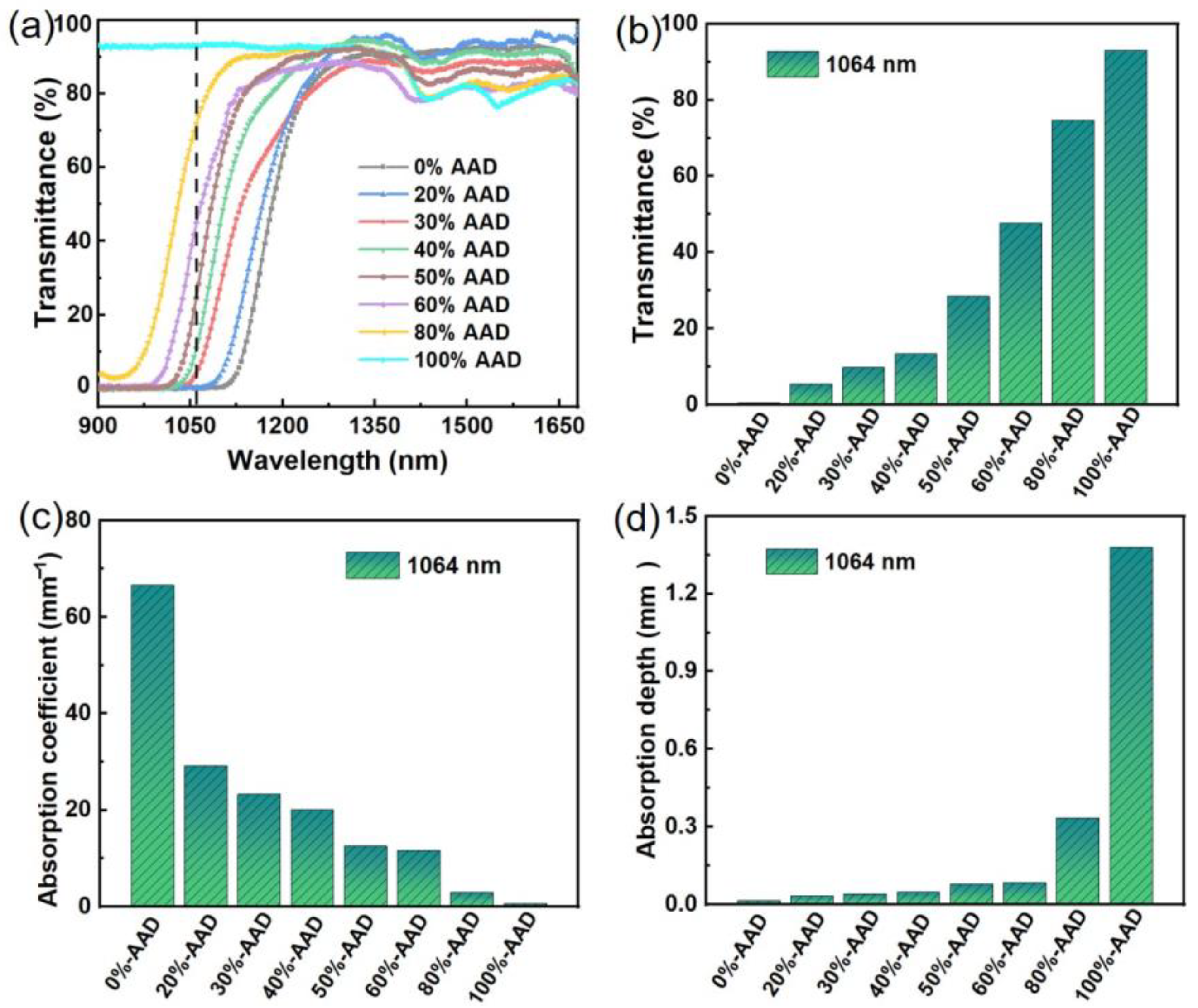
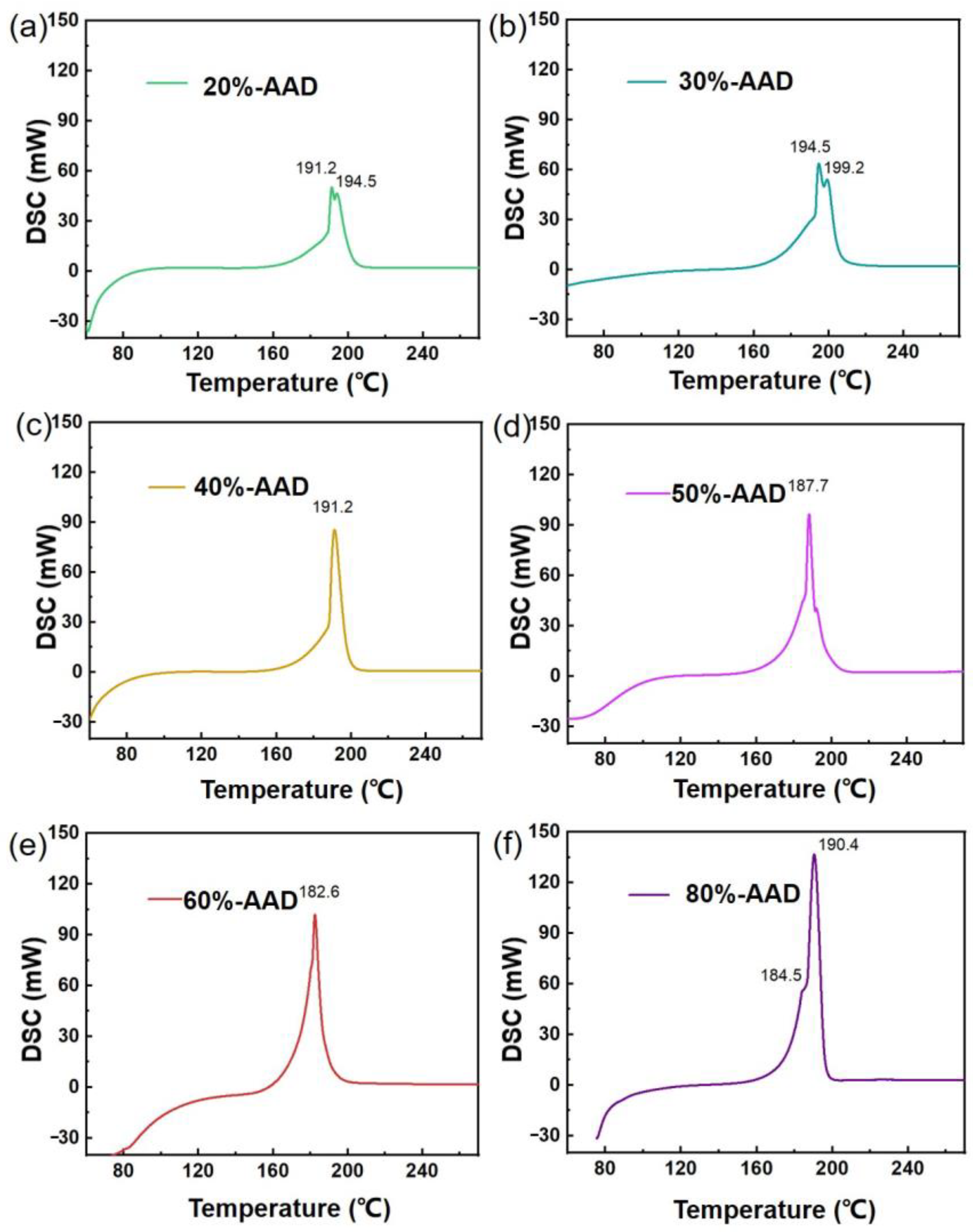
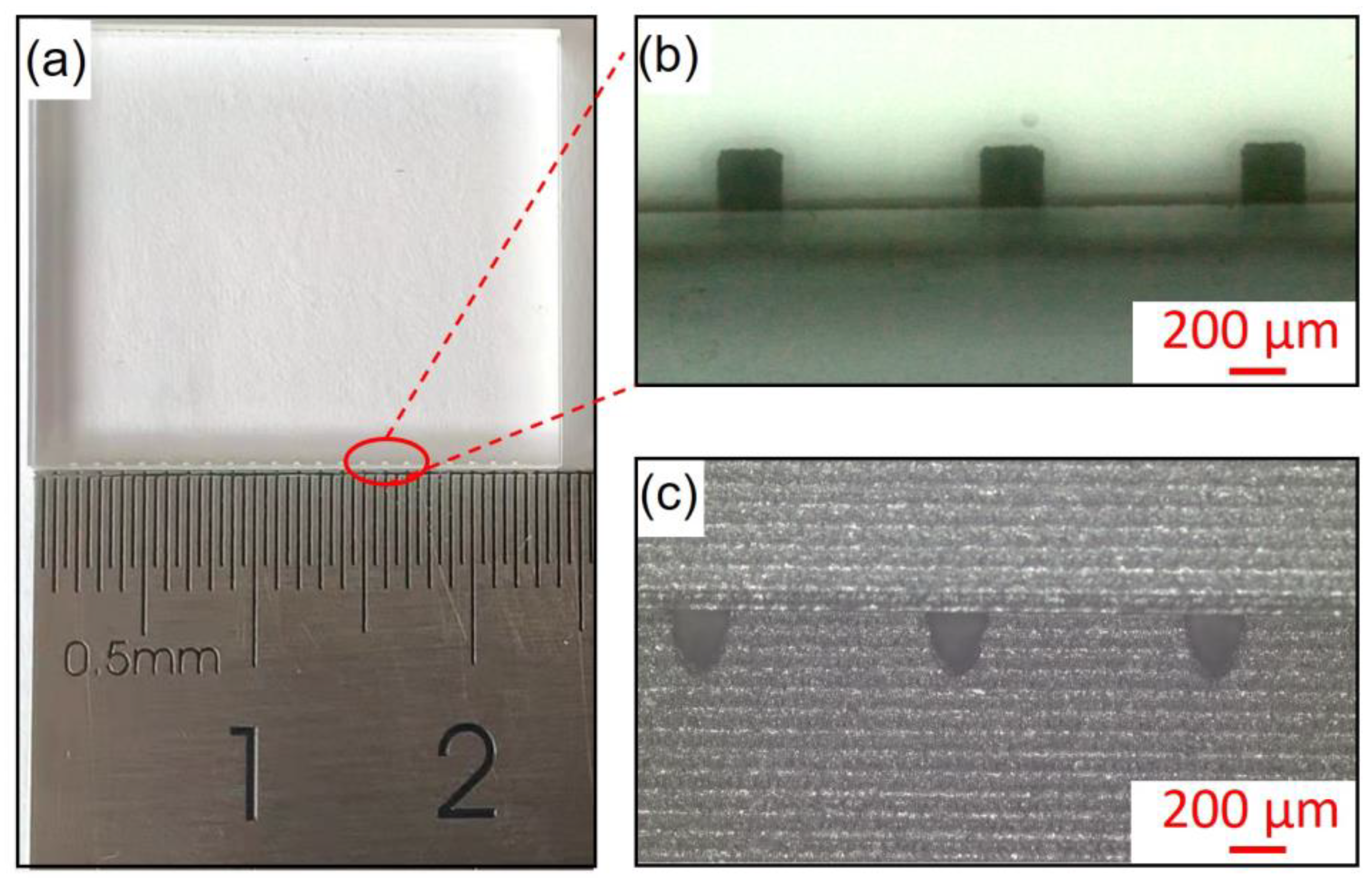
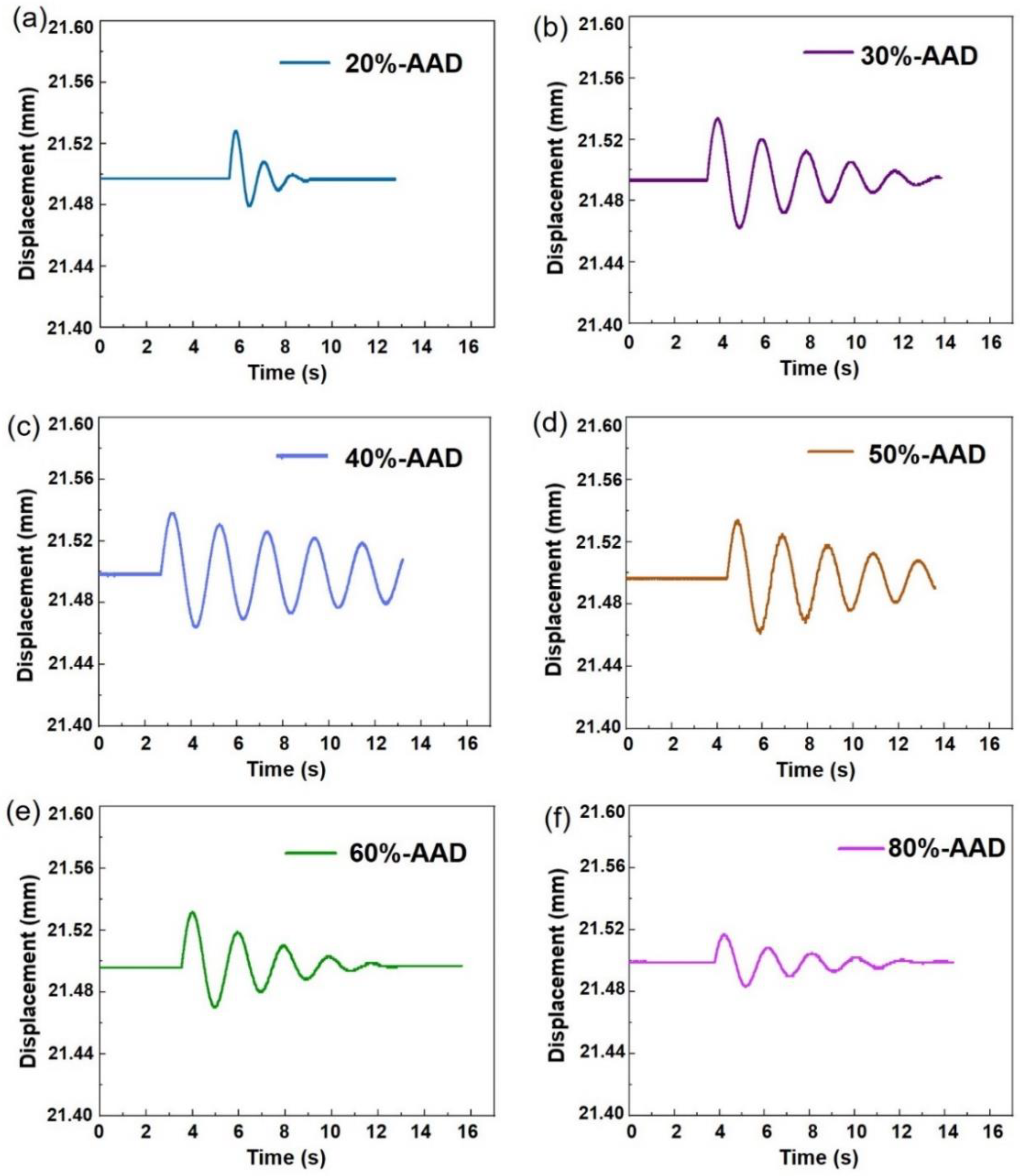
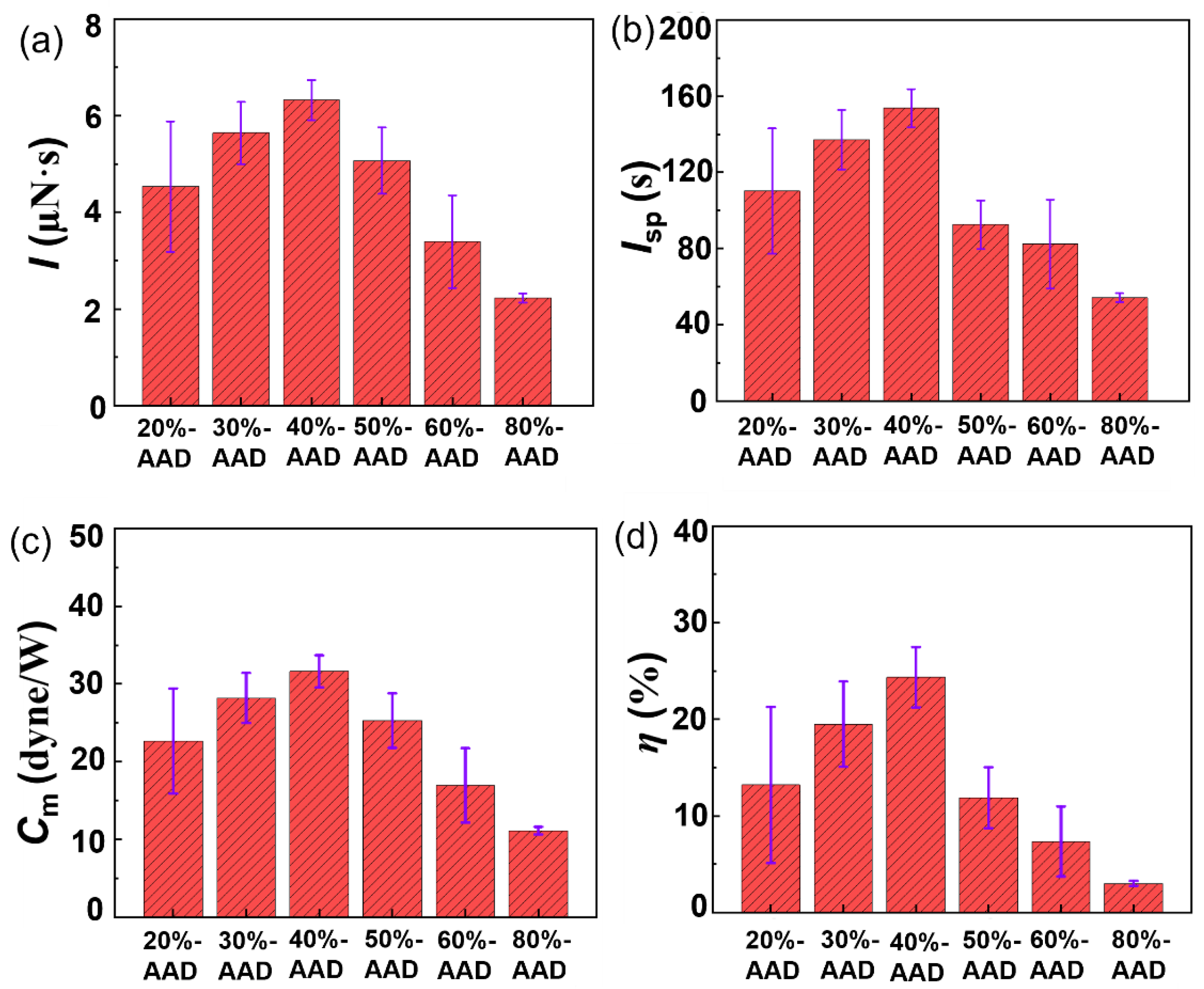


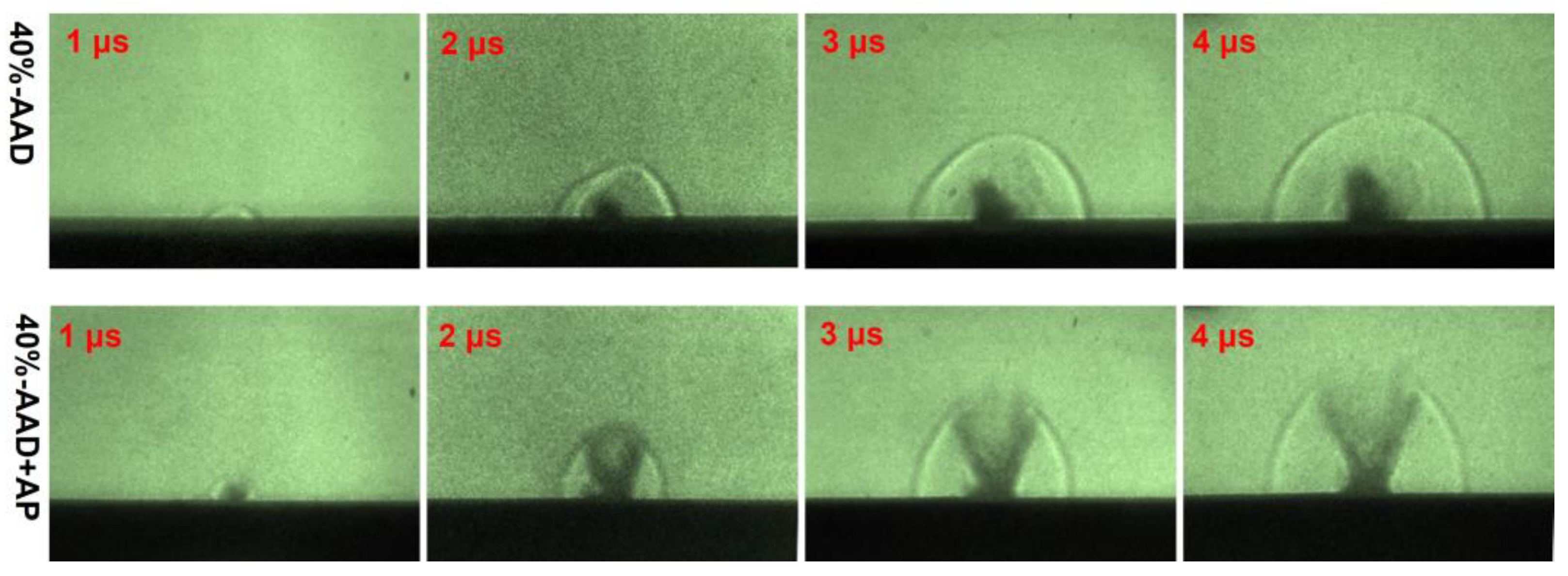

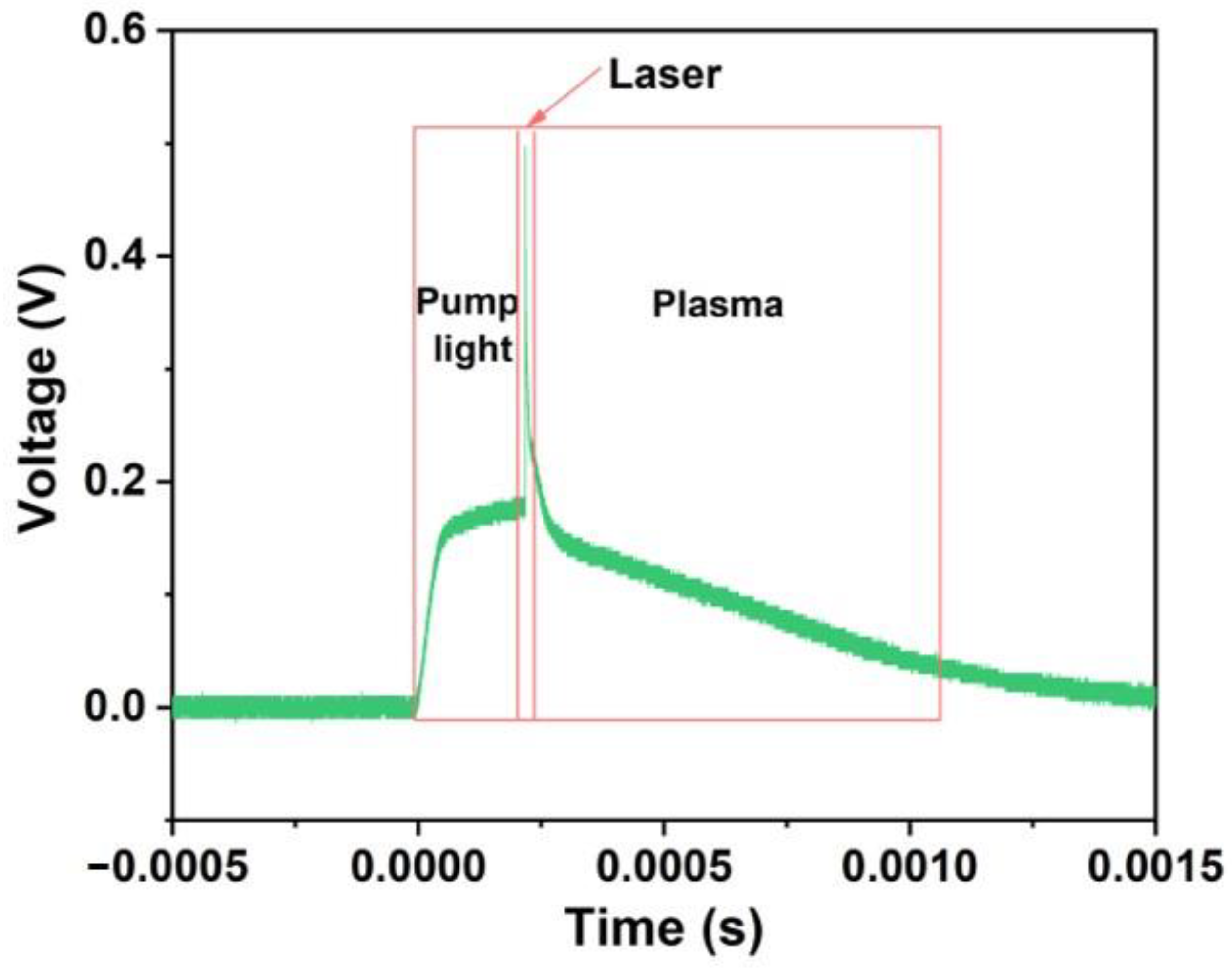
| Propellant Samples | Exothermic Peak Temperature (°C) | Enthalpy Variable (J/g) | Density (g/cm3) |
|---|---|---|---|
| 0%-AAD | 92.1 | +108.78 | 0.84 |
| 20%-AAD | 191.2, 194.5 | −303.3 | 1.06 |
| 30%-AAD | 194.5, 199.2 | −313.24 | 1.08 |
| 40%-AAD | 191.2 | −345.7 | 1.10 |
| 50%-AAD | 187.7 | −368.3 | 1.12 |
| 60%-AAD | 182.6 | −371.7 | 1.27 |
| 80%-AAD | 190.4 | −425.44 | 1.31 |
| 100%-AAD | 184.5 | −432.18 | 1.37 |
| Liquid Propellants | Combustion Chamber Volume (mm3) | Combustion Chamber Configuration | Ablation Performance | Application | References |
|---|---|---|---|---|---|
| ADN-based liquid propellant | π × 3.52 × 5.3 | Cavity | = 0.2 N Isp = 206 s | Chemical micropropulsion | [13] |
| ADN-based liquid propellant | 3.5 × 4.5 × 0.3 | Convergent-divergent nozzle | = 30 mN | Chemical micropropulsion | [27] |
| ADN-based liquid propellant | 20 × 20 × 0.05 | Rectangular cavity | Isp = 84.14 s Cm = 1070 dyne/W | Laser micropropulsion | [33] |
| ADN-based liquid propellant | 12 × 12 × 5 | Convergent-divergent nozzle | = 1.3 N Isp = 220 s | Chemical propulsion | [44] |
| 1% carbon-doped glycerol | 2.5 × 1.5 × 1.5 | Cuboid | Cm = 154 dyne/W Isp = 4 s | Laser micropropulsion | [45] |
| 30–60% ADN-based liquid propellant | π × 52 × 25 | Cavity | Isp = 213–282 s | Chemical propulsion | [46] |
| ADN-based liquid propellant | 1 × 5 × 25 | Glass tube | = 0.2–0.5 mN Isp = 20–50 s | Chemical micropropulsion | [47] |
| ADN-based liquid propellant | π × 2.6252 × 7.25 | Rectangular cavity | = 1 N Isp = 223 s | Chemical propulsion | [48] |
| Water | 3.6 × 2 × 1 | Convergent-divergent nozzle | = 4.5 mN Isp = 98 s η = 35.9% | Micropropulsion | [49] |
| ADN-based liquid propellant mixed with dye | 0.2 × 0.2 × 0.2 | Convergent-divergent nozzle | Isp = 234.9 s Cm = 62.4 dyne/W η = 71.2% | Laser micropropulsion | In this work |
Disclaimer/Publisher’s Note: The statements, opinions and data contained in all publications are solely those of the individual author(s) and contributor(s) and not of MDPI and/or the editor(s). MDPI and/or the editor(s) disclaim responsibility for any injury to people or property resulting from any ideas, methods, instructions or products referred to in the content. |
© 2023 by the authors. Licensee MDPI, Basel, Switzerland. This article is an open access article distributed under the terms and conditions of the Creative Commons Attribution (CC BY) license (https://creativecommons.org/licenses/by/4.0/).
Share and Cite
Du, B.; Zheng, Y.; Mao, C.; Cui, H.; Han, J.; Jiang, L.; Ye, J.; Hong, Y. Transmissive Mode Laser Micro-Ablation Performance of Ammonium Dinitramide-Based Liquid Propellant for Laser Micro-Thruster. Micromachines 2023, 14, 1219. https://doi.org/10.3390/mi14061219
Du B, Zheng Y, Mao C, Cui H, Han J, Jiang L, Ye J, Hong Y. Transmissive Mode Laser Micro-Ablation Performance of Ammonium Dinitramide-Based Liquid Propellant for Laser Micro-Thruster. Micromachines. 2023; 14(6):1219. https://doi.org/10.3390/mi14061219
Chicago/Turabian StyleDu, Baosheng, Yongzan Zheng, Chentao Mao, Haichao Cui, Jianhui Han, Luyun Jiang, Jifei Ye, and Yanji Hong. 2023. "Transmissive Mode Laser Micro-Ablation Performance of Ammonium Dinitramide-Based Liquid Propellant for Laser Micro-Thruster" Micromachines 14, no. 6: 1219. https://doi.org/10.3390/mi14061219
APA StyleDu, B., Zheng, Y., Mao, C., Cui, H., Han, J., Jiang, L., Ye, J., & Hong, Y. (2023). Transmissive Mode Laser Micro-Ablation Performance of Ammonium Dinitramide-Based Liquid Propellant for Laser Micro-Thruster. Micromachines, 14(6), 1219. https://doi.org/10.3390/mi14061219








